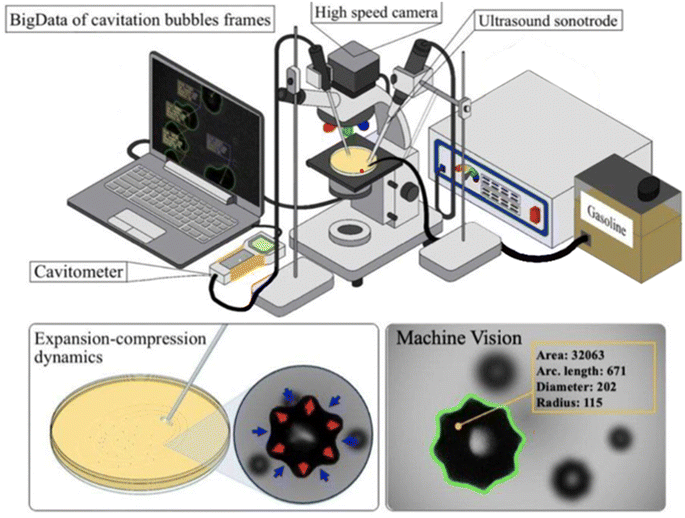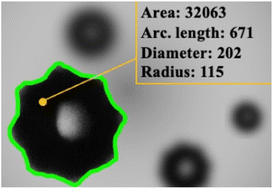Several papers related to Triboinformatics were prepared and published during my sabbatical at ITMO
1. A new paper in a series with ITMO students where properties of the liquid can be determined by Machine Learning methods from many images (video frames) of cavitation bubbles in a liquid. In this case, the liquid was gasoline.
T. Aliev, I. Korolev, O. Burdulenko, E. Alchinova, A. Subbota, M. Yasnov, M. Nosonovsky, E. Skorb “Automatic image processing of cavitation bubbles to analyze properties of petroleum products” 2024, Digital Discovery https://doi.org/10.1039/d4dd00003j

We have developed a new computer vision method of automatic image processing of cavitation bubbles to classify petroleum products with different octane numbers (ONs) using an artificial neural network (ANN). Ultrasonic irradiation induces cavitation bubbles, which exhibit growth, oscillations, and resonance shapes. Gasoline solutions may have different physical and chemical properties. While a precise understanding of how these properties impact bubble dynamics is challenging, training the ANN algorithm on bubble images allows classification of gasoline bubbles with different ON values. The integration of the ultrasonic cavitation method with computer vision and
2. A short review of how machine learning methods can be applied to situations of unstable solutions. This is based on the presentation at the International Workshop: Interplay of Mechanics, Tribology and Materials Science, Samarkand, September 4-6, 2023
M. Nosonovsky, A. S. Aglikov, 2024 Triboinformatics: Machine Learning methods for frictional instabilities. Facta Universitatis: Mechanical Engineering
https://doi.org/10.22190/FUME231208013N
The study of friction is traditionally a data-driven area with many experimental data and phenomenological models governing structure-property relationships. Triboinformatics is a new area combining Tribology with Machine Learning (ML) and Artificial Intelligence (AI) methods, which can help to establish correlations in data on friction and wear. This is particularly relevant to unstable motion, where deterministic models are difficult to build. There are several types of friction-induced instabilities including those caused by the velocity dependency of dry friction, coupling of friction with another process (wear, heat generation, etc.), the elastic Adams instabilities, and others. The onset of sliding is also an unstable process. ML/AI methods, such as Topological Data Analysis and various ML algorithms, which have been already used for various aspects of data analysis on friction, can be applied also to the frictional instabilities.
3. Several papers a in the series where Topological Data Analysis (TDA) methods, borrowed from image processing, are used for surface roughness analysis. The software, developed by the students, can generate diagrams called “barcodes” and “persistence diagrams,” which presumably contain additional information about surface roughness not captured by regular parameters. This method was applied to several interesting systems.
3a). AS Aglikov, TA Aliev, MV Zhukov, AA Nikitina, E Smirnov, DA Kozodaev, Michael Nosonovsky*, EV Skorb*, 2024, “Topological Data Analysis of Nanoscale Roughness of Layer-by-Layer Polyelectrolyte Samples Using Machine Learning”
ACS Applied Electronic Materials 5 (12), 6955–6963 https://doi.org/10.1021/acsaelm.3c01358

The surface roughness of layer-by-layer (LbL) polyelectrolytes is studied by atomic force microscopy (AFM) and analyzed with novel methods including topological data analysis (TDA) and machine learning (ML) to correlate multiscale roughness with the number of bilayers and to recognize the types of polyelectrolytes (PEs). LbL PEs composed of one to four bilayers of (1) polyethylenimine (PEI)/poly(sodium 4-styrenesulfonate) (PSS), (2) PEI/poly(acrylic acid) (PAA), and (3) PEI/MXene rigid flakes are deposited on a smooth silicon wafer. With a growing number of bilayers, the roughness changes from a smooth surface to an equilibrium rough profile. The AFM study of the surface morphology demonstrates that surface roughness is multiscale, with smaller features imposed on larger ones. Roughness data is filtered from measurement resolution artifacts, and several methods are applied: correlation length, statistics of the distribution of extremes in trimmed images, and TDA barcodes and persistence diagrams of simplexes in 8D data space. An ML algorithm is used to determine the number of bilayers in a PE. Roughness analysis indicates a gradual transition from a smooth to a rough surface with saturation at three to four bilayers and the existence of multiscale roughness invariance.
3b) MV Zhukov, AS Aglikov, M Sabboukh, DA Kozodaev, TA Aliev, SA Ulasevich, M Nosonovsky*, EV Skorb*, 2024 “AFM-Topological Data Analysis of Brass after Ultrasonic Surface Modification”, ACS Applied Engineering Materials 1 (8), 2084-2091 https://doi.org/10.1021/acsaenm.3c00233

Polished brass alloy plate samples were treated by ultrasound in an alkaline buffer at different concentrations and sonication amplitudes. Sample topography was studied by atomic force microscopy and processed by algorithms of topological data analysis. Persistence diagrams, barcodes, autocorrelation functions, and spatial distribution of heights (min–max regions) were constructed. The isotropy/anisotropy of the surface, the level of roughness, and grain size distribution were analyzed for all samples. The brass alloy samples with various grain sizes can be useful as structured coatings with controlled bactericidal effects due to the presence of copper.
3c) Ireddy, Ashish; Ghorabe , Fares ; Shishatskaya , Ekaterina ; Ryltseva, Galina; Dudaev, Alexey ; Kozodaev, Dmitry; Nosonovsky, Michael; Skorb, Ekaterina; Zun, Pavel, 2024, “Benchmarking Unsupervised Clustering Algorithms for Atomic Force Microscopy Data on Polyhydroxyalkanoate Films” ACS Omega (in press)
Surface of polyhydroxyalkanoate (PHA) films of varying monomer compositions are analyzed using atomic force microscopy (AFM) and unsupervised machine learning (ML) algorithms to investigate and classify films based on global attributes such as the scan size, film thickness, and monomer type. The experiment provides benchmarked results for 12 of the most widely used clustering algorithms via a hybrid investigation approach while highlighting the impact of using the Fourier transform (FT) on high dimensional vectorized data for classification on various pools of data. Our findings indicate that the use of a 1D FT of vectorized data produces the most accurate outcome. The experiment also provides insights into case-by-case investigations of algorithm performances and the impact of various data pools. Lastly, we show an early version of our tool aimed at investigating surfaces using ML approaches and discuss the results of our current experiment to configure future improvements.
